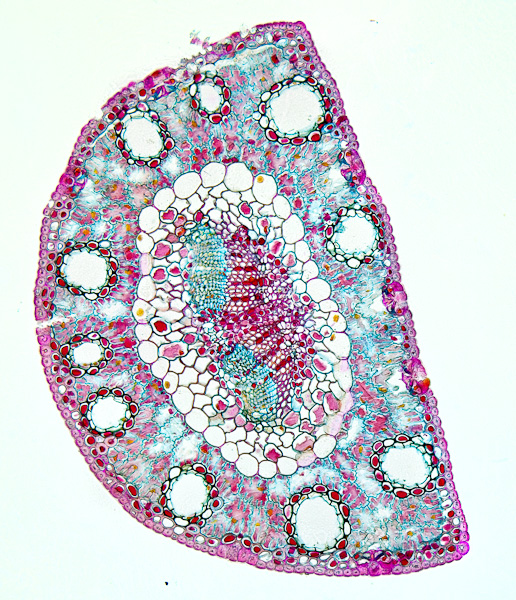Chapter 16 Basic Leaf Structure and Function
16.1 Leaf Anatomy
Each leaf on a tree is a highly organized factory for converting sunlight, carbon dioxide, and water into sugars and amino acids that the tree can use to grow, repair injuries, resist disease, and reproduce. Leaves also are the engines for transpiration, the process by which water is pulled up from the roots to the rest of a tree.
Part 1. Parts of a leaf - a) plant stem; b) leaf axil; c) leaf petiole or stalk; d) leaf blade. Part 2. Microscopic cross-section through the layers of a privet leaf, 100x magnification. Link to original image 1; link to original image 2

Schematic of the structure of a typical leaf. Link to original image
The outermost layer of leaves is a waxy cuticle that prevent the inner cells from drying out. Just inside of the cuticle is a thin layer of epidermis. The layer on the upper side of the a leaf is continuous, while the epidermis on the underside has tiny openings called stomata that allow carbon dioxide in, and water and oxygen out. These openings control how much water evaporates from inside of the leaves, which in turn control the rate of transpiration.
Between the epithelium layers are vascular bundles of xylem and phloem; they form the veins that we see. Also between the epithelium layers are the thick spongy and palisade layers. Xylem carries water with dissolved nutrients (nitrogen, phosphate, potassium, and micronutrients) up from roots to leaves. The green chlorophyll-containing cells in spongy and palisade layers undergo photosynthesis. They combine water delivered by the xylem tubes with carbon dioxide that comes in through the stomata openings to make sugars. Leaf cells then chemically combine some of those sugars with nitrogen in the form of ammonium ions (also delivered by xylem tubes) to make amino acids. Sugars and amino acids then are transported out of the leaves via the phloem tubes to the rest of the tree.

Close-up schematic of the layers of a typical leaf. Link to original image

Skeleton of leaf veins. Link to original image
16.2 Needles
1. Needles on a white spruce. Link to original image. 2. Microscopic cross-section through the layers of a pine needle, showing how the anatomy differs from deciduous leaves. The stomata are present on all sides of the needle rather than just the lower surface, and there are only two bundles of xylem and phloem in the center of the needle. The colorless openings just beneath the epithelium are resin tubes. Link to original image
Conifers (pines, spruces, larches, cypress, cedars, etc.) have either needles or scale-like foliage. Both types of foliage are highly adapted to handle extreme conditions. The stomata are in lines or patches on all sides of the needles or scales and can be closed to preserve moisture when it is very dry or cold. The outer layer of resin-containing tubes prevents needles and scale foliage from freezing even at temperatures well below O^o F. The resin also prevents insects and many other animals from feeding on needles. Species that are adapted to high altitudes will have an additional waxy bloom on the needles that protects them from UV light.
16.2.1 Deciduous Needles
Most conifers are evergreen, so their leaves can remain for several years or even decades before dying and falling off. Five genera (Larix, Pseudolarix, Glyptostrobus, Metasequoia and Taxodium) are deciduous, shedding their needles each autumn and remaining leafless through the winter.
Why do most conifers have needles that last several years, while these trees drop them each autumn? Again it is a strategy for maximizing survival in tough conditions. Current thinking is that making needles that last multiple years requires more nutrients from the soil. Several deciduous conifers (baldcypress (genus Taxodium), Glyptostrobus and dawn redwoods (genus Metasequoia) specifically) evolved to grow in wet or seasonally saturated soil that is nutrient-poor. Deciduous needles are an adaptation to the marginal soil quality. In exchange, these species often grow in areas where other trees cannot.
Larches (genera Larix and Pseudolarix) are thought have evolved a deciduous habit for a different reason. They often grow in areas with heavy snow pack and deep winter cold. Other evergreen conifers often have frost damage and broken limbs from snow loads. By shedding their needles, larches can recycle a large part of the nutrients, and eliminate most of the surfaces that would capture snow.



